
|
Lorna Mills and Sally McKay
Digital Media Tree this blog's archive OVVLvverk Lorna Mills: Artworks / Persona Volare / contact Sally McKay: GIFS / cv and contact |
View current page
...more recent posts
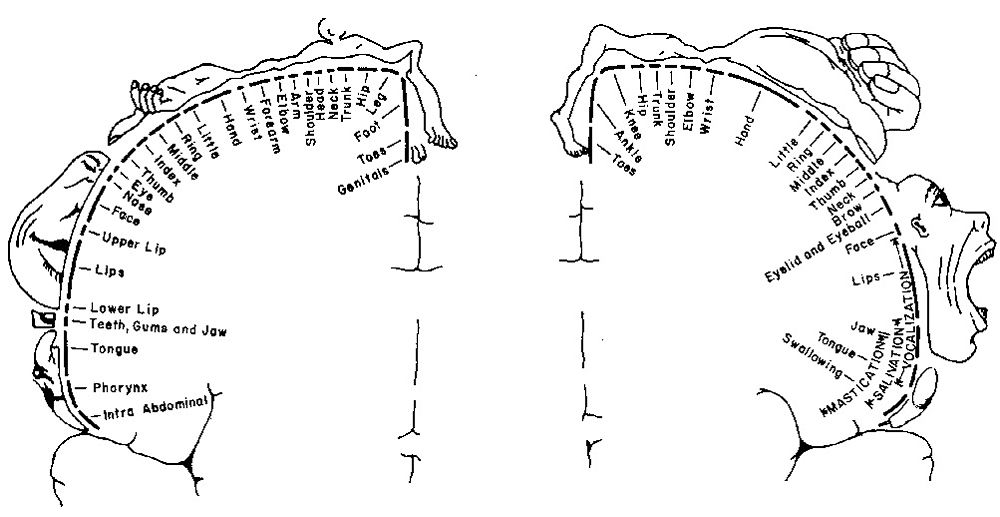
This is the famous brain map of sensory input by Dr. Wilder Penfield called the "homunculus." Wikipedia warns us that it's not necessarily totally accurate, and may be out of date. But in general it illustrates that our body parts are mapped on the cortex of the brain. But the brain doesn't just map our body, it also maps the area around us. Sandra Blakeslee is a science writer who co-authored Phantoms in the Brain with VS Ramachandran and recently wrote all about brain mapping with her son Matt, in a book called The Body Has a Mind of It's Own. On the Brain Science Podcast she described how she got the idea for the book while browsing the posters at a big neuroscience conference.
There was a paper by an Italian neuroscientist that talked about perispersonal space, which I had never heard of. So I went over and starting asking him, and we were talking about strokes and this method he had of studying strokes. And then I said to him, "What's peripersonal space?" And he — it's so cute — he stepped back and took a pen and he said, "You see this pen? It is now outside of your peripersonal space." And then he went dvvvf, dvvvf, dvvvf and started moving it closer and closer to me. And then he got it into the area around me. If you put your arms out over your head, and to your side and down by your hips, that's your peripsersonal space. And he was telling me that that space is actually mapped in your parietal lobe. I couldn't believe it. I knew that the brain maps the body, I knew about the Penfield maps and the classic touch maps and motor maps, but the idea that the space was mapped... And when you use tools the maps increase in size. ... It was just enchanting. And then a bunch more findings were coming along at that time about tool use, and mapping, and about mirror neurons which are about mapping your social world. And then this whole thing about inner reception, which is how you map the internal feelings in your body... this was so exciting...Later in the interview she explains how this mapping of the perispersonal space can account for why we are aware that there is somebody behind us, etc. She also describes how out of body experiences can be induced with elecrtrode stimulation in the right angular gyrus, and how seeing auras can result from synaesthesia. And she says this rather sweet thing...
Some people when they are very young start seeing coloured auras around others. They're not making it up, they really do see that. And in fact people that have those kinds of really strange synaesthesia think it's perfectly normal. They reach their late teens before they realise that not everybody sees the world that way. Out of body experiences, near death experiences, healing touch — we're proposling neurophysiological explanations for a lot of these phenomena that are routinely described as the paranormal. And no wonder! I mean, if you have an out of body experience it's real, you're not making it up. And then modern science comes along and says "Oh, no no no, that can't be." So people are drawn to the parapsychology world for the lack of an explanation from the more allopathic scientific world.
Sunday Devotionals - Soeur Sourire
Suggested by my studio assistant (Ed Pien's mostly) and artist, Joel Thomson, who thinks this is funny, frankly I don't, it all looks pretty normal to me.
Dominique, outsold Elvis for four weeks on the Billboard Charts in 1963.
From the movie with Debbie Reynolds
Updated disco version with Soer Sourire looking very hip and Vatican II
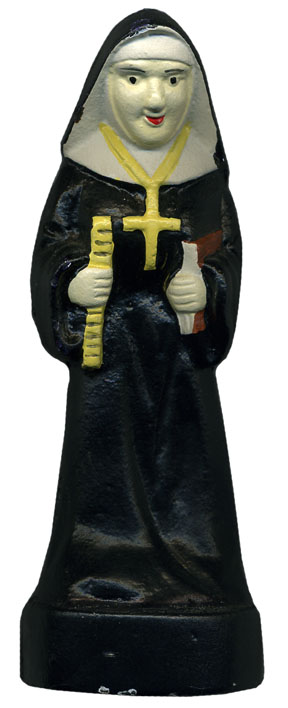
A friend* recently brought me this cast iron Nun beer opener from Montreal.
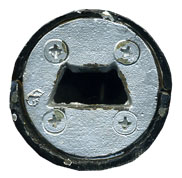
Obviously made in prison by Maurice "Mom" Boucher, former head of the Quebec Hells Angels.
Speaking of Montreal, to answer an inane and popular rhetorical question, it is not the New Vancouver, Montreal is the best place in the universe.
[*Worst Art Critic in Canada]



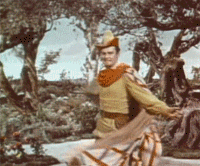
(found)
Neurobotics in action.
Here are some quotes from a presentation by Yoky Matsuoka on neurobotics (thanks to joseter).
...we are so good with our hands, a lot of people say that our hands are the reason why we have this society. We can use tools, we can build buildings, we can even have this level of consciousness, some people believe, because we can gather amazing sensory information from our hands, and manipulate objects in a way that other primates don't do.
We want to build a mechanical device that's controlled by the original brain signals that would mimic our own limb, and nobody else could tell that its actually a robotic device.
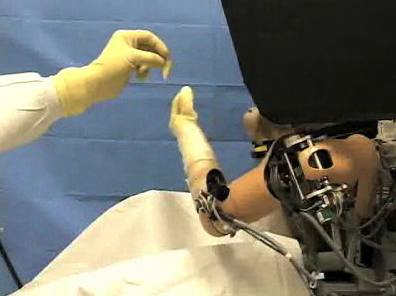
This image is from Matsuoka's presentation. It's a monkey with electrodes in it's head. The brain area is interestingly masked off by a black blob. Dunno if that's to keep the audience from getting sad for the monkey, or if the tech is proprietary and they want to keep it secret, or what. Anyhow, the money's arms are tied down and he's controlling that robotic arm by thinking. But the grasping part of the action is being controlled by a human off to the side with a remote controller, because, as Matusoka says, "that level of detail we can't get yet." They currently working on some superdextrous robotic hands, trying to match up the machinery with the neurology.
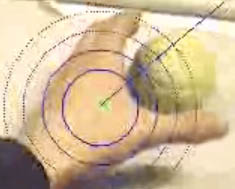
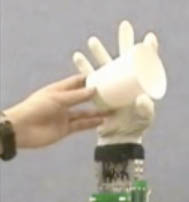
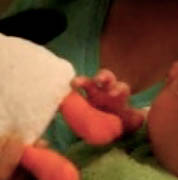
Grasping is a big deal in neuroscience. It's one of the first things we do, and we happen to be pretty good at it. Mirror neurons were discovered when scientists were looking at a monkey's brain function during grasping. Grasping is a big deal because of prosthetic design, robot design and the lingering fascination with AI.
The frontal lobe is big in humans and this probably accounts for why we get up to so much complicated business like global capitalism and network technologies and art that animals don't bother with. The frontal lobe takes care of planning and evaluating and setting goals. But it is also responsible for motor control. Recently on Dr. Ginger Campbell's Brain Science Podcast, Dr. Art Glenburg explained a bit about the study of embodied cognition, which explores the hypothesis that "high level cognition is really based on lower level processes," such as "neural systems that control action, neural systems that control perception, and neural systems that control emotion." This work in cognitive psychology predates the discovery of mirror neurons in neuroscience. Mirror neurons add emphasis to the concept that the "brain evolved for action."